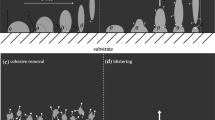Abstract
Proposed regulations by the U.S. Department of Energy have spurred development of energy-efficient washing machines that utilize less water and operate with lower energy requirements than conventional machines. As a result, major changes in washing machine design are required. Among expected changes are increased use of a horizontal-axis wash tub, an increase in fabric-to-wash liquor ratio, greater surfactant concentration in the wash water, and reduced average washing temperatures. As a result, surfactants used in future detergent formulations will be required to clean effectively in this new regime while producing minimal foam. Detergency test methods utilizing radiotracer techniques have been developed to study the detergency process in energy-efficient washing machines. Detergency and redeposition of radiolabeled oily soils can be determined in a full-size horizontal-axis washing machine through scintillation counting of wash and rinse water samples. Measurements can be made after each wash process step and combined to determine total cycle detergency. This is a distinct advantage over conventional reflectance detergency methods where only total detergency at the end of the entire washing and rinsing process can be conveniently measured. Also, in contrast to indirect reflectance methods, measurements of absolute soil removal are obtained with the radiotracer method. In this study, soil redeposition was determined by measuring residual radioactivity on fabric swatches and then performing a material balance on the oily soil.
Similar content being viewed by others
References
Raney, K.H., P.G. Shpakoff, and D.K. Passwater, Nonionic Surfactant Properties at Conditions Relevant to Energy-Efficient Detergency Processes, in Proceedings of the 4th CESIO World Surfactant Congress, Vol. 2, Barcelona, 1996, p. 50.
Cahn, A., The Laundering Process, HAPPI 32(6):77 (1995).
Houston, J.H., Detergents: Changing Expectations, Contents, INFORM 8:928 (1997).
Roth, G.Y., Laundry Detergent Review, HAPPI 35 (1):83 (1998).
Kirschner, E.M., Product Report: Soaps & Detergents, Chemical & Engineering News 76(4):39 (1998).
Shebs, W.T., and B.E. Gordon, Improvements in Detergency Precision with Radioactive Soil, J. Am. Oil. Chem. Soc. 45:377 (1968).
Prieto, N.E., Radiotracer Detergency Method, Ibid. 66:11 (1989).
Schmidt, W.W., D.R. Durante, R. Gingell, and J.W. Harbell, Alcohol Ethoxycarboxylates—Mild, High-Foaming Surfactants for Personal Care Products, Ibid., 74:25 (1997).
Author information
Authors and Affiliations
Corresponding author
About this article
Cite this article
Passwater, D.K., Raney, K.H. Radiotracer detergency testing in a horizontal-axis washing machine. J Surfact Deterg 2, 167–173 (1999). https://doi.org/10.1007/s11743-999-0070-y
Received:
Accepted:
Issue Date:
DOI: https://doi.org/10.1007/s11743-999-0070-y




